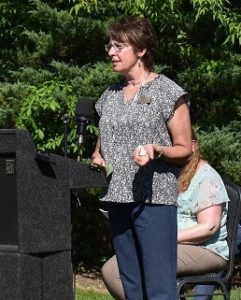Hello Fellow Readers, What a privilege to participate in a Butterfly Release Celebration hosted by Karen Ann Quinlan Hospice. It’s their 20th year of the celebration and the 40th year of serving our community. Previously they’ve held the event live in the counties they serve- Sussex and Warren in NJ and Pike County, PA. This year it was recorded in advance and shared by way of video conferencing.
 8,200 butterflies released over twenty years
8,200 butterflies released over twenty years
The six dozen monarchs in the large wooden frame with wire sides and a floor of flowers were glorious—a glass butterfly suncatcher hung in the center. Names read, and songs sung.
Robert (Bob) McCracken of Smith-McCracken & Wood Funeral Homes, generous supporters for forty years, emceed the event. He shared they’ve released 8,200 butterflies in our community over the last twenty years, raising over 640 thousand dollars to serve patients and their families during their time of need.
How butterflies are procured and released
I hadn’t realized before then how often butterfly releases occur in memorial and wedding celebrations. Chilled into a dormant state, they are usually shipped overnight the day before an event. There are concerns that farm-raised butterflies may spread disease into the wild populations and uncertainty if they can migrate. Fortunately, the International Butterfly Breeders Association helps its members to follow strict guidelines for the safety of the butterflies, the environment, and educating consumers releasing them.
Butterflies should be released in temperatures above 65 degrees, no later than two hours before dusk, so that they can feed. Not to say they won’t survive if its cooler, but they may fly slowly if at all making them more vulnerable to predators.
A heartfelt reflection by Diana Sebzda
A highlight of the Karen Ann Quinlan Hospice Butterfly Release Celebration was reflections shared by my former grief counselor become friend Diana Sebzda, Director of Bereavement. Diana contemplated that it’s hard to imagine in the beauty of the surroundings and butterflies that there’s a pandemic going on.
“When something painful, sad, or bad happens, we tend to laser focus on those things. And when we do that, all the other things around us become blurry and unfocused and even fuzzy,” Diana said.
As an example, while they were setting up for the ceremony, she noticed the tree behind the podium had heart-shaped leaves. Diana hadn’t seen them before and wondered how she could have missed that.
As she was speaking, I thought how remarkable that last week’s column was about a Redbud. It hadn’t occurred to me when we chose Myles memorial tree that, in addition to the stunning transformations the tree undergoes from season to season, it has heart-shaped leaves. What a “coincidence” that she discovered the same thing. And, as it turns out, Redbuds are host trees providing egg laying stations for butterflies.
“Isn’t that why we are here today? Because of love…”
Diana went on to suggest that we look beyond our laser focus to find the beauty and love that surrounds us.
“Look around, and you will find it. You will find love,” she said with strong affirmation. “Isn’t that why we are here today? Because of love. Love for someone who has passed before us and love for people who are still here with us.”
Diana concluded, “When we find ourselves becoming laser-focused, let’s think of love. And let that love refocus us to be able to see and find the good that is around us.”
Her wisdom fills me, and I hope you too.
Garden Dilemmas? AskMaryStone@gmail.com (and now on your favorite Podcast App.)
Diana’s reflection in full is featured in the Garden Dilemmas Podcast:
Click through to a previous column – A Forest Pansy Redbud of Hope.
Helpful Links:
International Butterfly Breeders Association




